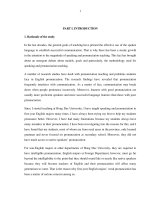Using Spectrophotometry to Improve your Brewing Process pot
Bạn đang xem bản rút gọn của tài liệu. Xem và tải ngay bản đầy đủ của tài liệu tại đây (870.15 KB, 28 trang )
Using Spectrophotometry to
Improve your Brewing Process
Rick Blankemeier
Quality Assurance Analyst
Stone Brewing Co.
Goals
• Introduce the UV-Vis Spectrophotometer
• Provide financial justification for purchase
• Describe ways to use this device to help
breweries expand and improve their brewing
and fermentation operations
• Quick and easy access to vital info on different
assays and procedures using the UV-Vis Spec
• Gives brewers the ability to find the
concentration of a certain substance in your
beer by measuring absorbancy
UV-Vis Spectrophotomer
UV-Vis Spectrophotomer
• Use
– Anyone can use a UV-spec with any level of
technical expertise
– It’s harder to operate a brewhouse than a UV-Spec
– A background in chemistry or biology doesn’t hurt
when preparing the samples, but it’s not needed
Hach DR5000
Quartz Cuvettes
UV-Vis Spectrophotomer
• Preparing Samples
– Degas
• Same procedure to check fermenting beer gravity via
hydrometer
• Sonicate
– Usually don’t want to filter samples for clarity
• Centrifugation at 2000-3000rpm
– Sometimes the procedure calls for heating/cooling
of samples
UV-Vis Spectrophotomer
• Cost
– UV-Spectrophotometer
• $5000-$7500 plus warranty and service contract
• $300-$400 for quartz cuvettes
• Cost Benefit Analysis
– Mostly deals with “what-if” scenarios and finding
root causes
– Skewed towards packaging breweries for
consistency’s sake
Justification
• How can you justify a $7500+ purchase?
– How much would it cost you to dump a batch of beer?
$5000? $10000?
– Forced to change suppliers -> how does it affect your
beer?
– Change an aspect of the brewing process (grist profile,
water chemistry, etc.) How does that affect your process?
– How much would it save you to keep your beer on the
shelf for an extra month?
– Able to increase the batch size of your brew relatively
painlessly AND keep the flavor and quality consistent?
Expansion and QA Concerns
• Lots of successful small to mid-size breweries
planning 25-50% expansions to their capacity
• Growth for craft breweries in the 15,000-30,000
bbl/year range are expected to grow at a double-digit
rate this year
• Quality testing your beer off of the new system
needs to be a priority – compare with old system
Scaling Up Your Process Is Easy…Right?
– Scaling up recipes and your brewing process isn’t just a
matter of ratios
– You need to establish empirical standards for your beer
before you increase your capacity so you know what
analytical targets you need to meet on your new system
– Every brew system is different! Even if it’s from the same
manufacturer
– Sensory testing is important as well
(Empire)ical Standards
• Gravity – Hydrometer or Density Meter
• pH – pH Meter
• IBUs - Spectrophotometer
• Color – Spectrophotometer
• ABV – Anton Paar Alcolyzer or Ebulliometer
Analytical Testing
• Level 1
– Color Analysis (ASBC Method Beer 10A)
– Bitterness (ASBC Method Beer 23)
• Level 2
– Beta-Glucans (Custom Method)
– Polyphenols (ASBC Method Beer 35)
• Level 3
– FAN (ASBC Method Beer 31)
– TBARS (Method on the kit)
Color Analysis
• One of the simplest assays using a
spectrophotometer
• Measures SRM
• Good to establish color thresholds for your
core brands
• Diagnose specialty grain or grainout issues
Color
• Waste/Hazard Issues
– None, able to dispose of
reagents down the drain w/o
treatment
• Cost
– Little to none (besides cost
of spectrophotometer).
• Cost Benefit
– Establish color specs for your
core beers
– Gives you the ability to
adjust the color to your
needs
• Colorimetric at
430nm
• Measures
absorbency in the
blue part of the
visible spectrum of
light
Bitterness
• Measures the approximate* amount of iso-
alpha acids in a sample
• Uses liquid-liquid extraction to separate the
iso-alpha acids* from acidified wort/beer into
2,2,4-trimethylpentane (iso-octane)
• Great for establishing an empirical
specification for your core beers
• Also great for determining hop utilization
*1 IBU ≠ 1 ppm iso-alpha acid
Bitterness
• Waste/Hazard Issues
– Need to dispose of iso-octane
in special solvent waste
containers after measurement
• Cost
– ~$200-300/month in chemicals
and centrifuge tubes
– $300/year in disposal fees
– A centrifuge that can spin at
2000-3000 rpm
• Cost Benefit
– Hop savings through utilization
study (~$5,000/month)
– Scalability through establishing
specs
• Measures
absorbency at
275nm
• Uses 6M HCl and
iso-octane
• Abs x 50 = IBU
TBARS Assay
• TBARS = Thiobarbituric Acid Reactive
Substances
• Measures the concentration of oxidative
precursors in wort due to lipid peroxidation.
• Overheating your brew leads to free radical
formation
• Free radical formation leads to oxidation.
• Oxidation in beer leads to suffering (and poor
shelf-life)
TBARS Assay
• Waste/Hazard Issues
– None, able to dispose of
reagents down the drain
w/o treatment
• Cost
– A $400 kit good for 60
tests
– Need a water bath that
can maintain constant
temp.
• Cost Benefit
– Less wasted energy (Save
~$1000/month)
– Improved beer shelf life
• Colorimetric at 517 nm
• Measures against a
MDA standard to
generate a standard
curve
y = 0.0052x + 0.0138
R² = 0.9923
0
0.1
0.2
0.3
0.4
0.5
0.6
0 50 100 150
Standard Curve
Standard Curve
Linear (Standard
Curve)
nmol/
Abs
Free Amino Nitrogen (FAN)
• FAN represents the concentration of individual amino
acids, ammonia, and end-group α-amino nitrogen in
small peptide chains and proteins
• Basically, it measures the bioavailability of nitrogen to
yeast.
• Adjunct brewers have to worry about low FAN levels
• Too much FAN = potential micro issues and fusel oil
formation in high gravity beers
• Don’t worry about adding nutrients like urea!
• High FAN can also lead to haze issues and some amino
acids can also lead to higher diacetyl formation rates in
fermenting beer
Free Amino
Nitrogen
• Waste/Hazard Issues
– None, able to dispose of
reagents down the drain w/o
treatment
• Cost
– ~$20-25 per 16 sample group
– Water bath with temp. control
(~$900 for a 2L)
• Cost Benefit
– Fewer micro and sensory
issues
– Less haze issues
• Ninhydrin-based dying
method
• Ninhydrin color reagent
keeps for about 2 weeks
• Measures against a
glycine standard curve
• Absorbency at 575nm
• Good range is 140-300
mg/L
Beta-Glucans
• Polysaccharides of D-glucose linked by β-
glycosidic bonds
• Appears primarily in wheat malts, oats, rye
malts, and in barley malt to a lesser extent
• It’s the sticky stuff in your mash that causes
stuck lauters and angry brewers.
• It also can lead to haze issues post-fermentation
Beta-Glucans
• Waste/Hazard Issues
– None, able to dispose of
reagents down the drain w/o
treatment
• Cost
– ~$1.50 per test
• Cost Benefit
– Diagnose haze issues in beer
– Utilize enzymes to help with
poor lauters or haze issues
• Congo Red Assay –
measures absorbency at
540 and 477 nm (green-
blue visible wavelength)
• Measures the amount
of beta-glucans that are
bound by the dye
• Based on an assay used
primarily in histology –
diagnosis of fungal
infections
Polyphenols/Tannins
• Comes primarily from darker malts, hops,
barrels/wood aging
• Imparts strong flavors – too much and it causes
astringency
• Complexes with proteins at low temperatures to
form chill haze
Polyphenols
• Waste/Hazard Issues
– None, able to dispose of
reagents down the drain w/o
treatment.
– Ammonia is concentrated and
stinky
• Cost
– ~$100 for 20 tests
• Cost Benefit
– Potential for determining
when a barrel has given up all
of its flavor
– Potential to diagnose haze
issues in beer
• Ferric iron binds to
polyphenols
• Good way to monitor
post-dryhop tannin
levels
• Absorbance at 600nm
Summary
• Establish empirical standards for your beer
• Scale up your brewery keeping those
standards in mind
• Cost vs. cost benefit – well worth the purchase
• If you have any questions about the
procedures or anything else, you can reach me
via e-mail
–









